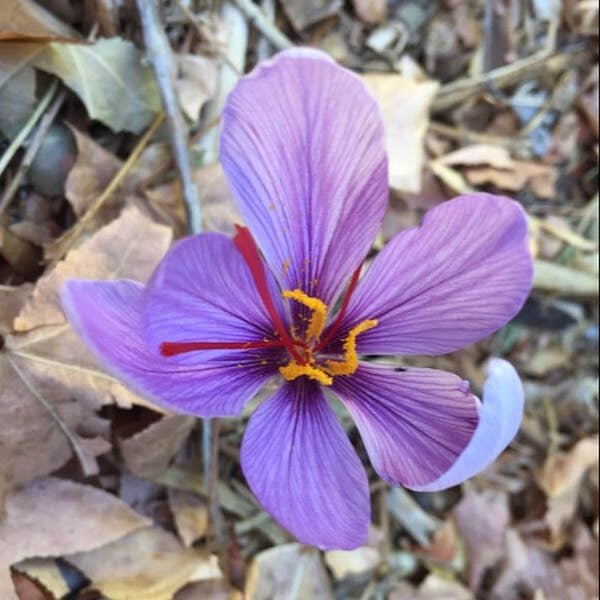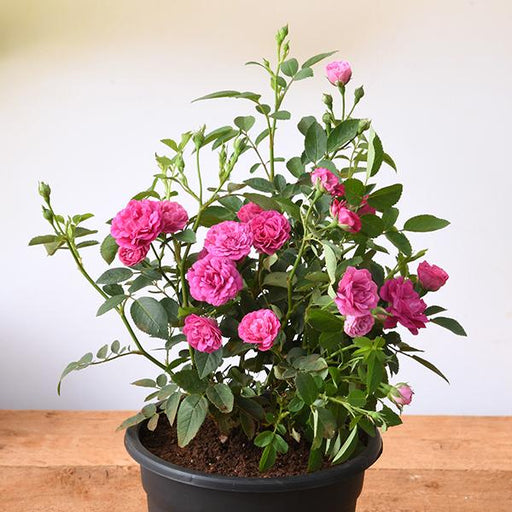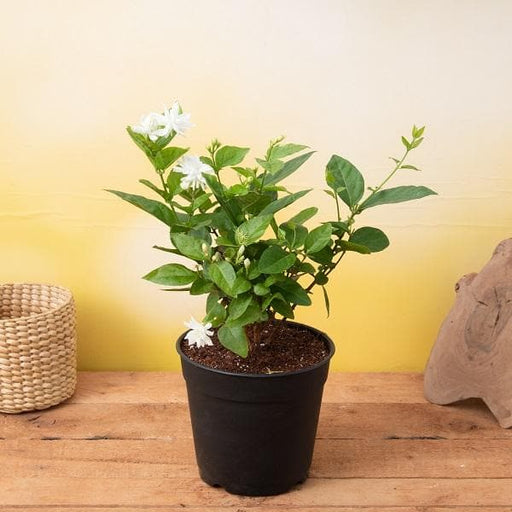
Kesar (crocus) - Plant
(MRP Inclusive of all taxes)
- Shipping ₹79 for entire order
- Dispatch in 7 days
- Country of origin: India

(MRP Inclusive of all taxes)
 Save 29%
Save 29%
Air Purifier Money Plant with Pot The Air Purifier Money Plant, also known as Pothos or Epipremnum aureum, is a stunning indoor plant that...
View full details
 Save up to 15%
Save up to 15%
Peace Lily, Spathiphyllum - Plant The Peace Lily, scientifically known as Spathiphyllum, is a stunning houseplant celebrated for its elegant white...
View full details
 Save 25%
Save 25%
Jasminum sambac, Mogra, Arabian Jasmine - Plant Jasminum sambac, commonly known as Mogra or Arabian Jasmine, is a fragrant flowering plant...
View full details
 Save 18%
Save 18%
Combo Constituents Includes the Parijat Tree (Night-Flowering Jasmine), a culturally significant plant with fragrant flowers. Description The Pari...
View full details
 Save 25%
Save 25%
Miniature Rose, Button Rose (Any Color) - Plant The Miniature Rose, also known as the Button Rose, is a charming and compact flowering plant that ...
View full details Save 25%
Save 25%
Damascus Rose, Scented Rose (Any Color) - Plant The Damascus Rose, also known as Rosa damascena, is a timeless symbol of beauty and romanc...
View full details
 Save 17%
Save 17%
Beautiful Fragrant Mogra, Arabian Jasmine Plant with Pot The Beautiful Fragrant Mogra, also known as Arabian Jasmine (Jasminum sambac), is...
View full details Save 15%
Save 15%
Pack of Vermicompost and Neem Cake for House Plants Transform your indoor garden with our premium Pack of Vermicompost and Neem Cake, spec...
View full details
Pack of Plant Growth and Flower Boosters Unlock the full potential of your garden with our Pack of Plant Growth and Flower Boosters! This ...
View full details Save 38%
Save 38%
Combo of Jeevamrut and Neem Raksha for Easy Growth and Protection of Houseplants Transform your indoor garden with our exclusive combo of ...
View full details Save 22%
Save 22%
Plant Nutrients Kit (Pack of 16) for a Healthy Garden Transform your garden into a lush paradise with our Plant Nutrients Kit, featuring 1...
View full details Save 16%
Save 16%
Combo of Top Plant Fertilizers Elevate your gardening game with our exclusive Combo of Top Plant Fertilizers, featuring two bags of premiu...
View full details Save 24%
Save 24%
Pack of 4 Additives to Make Soil Healthy and Nutrient Rich Transform your garden into a thriving ecosystem with our Pack of 4 Additives de...
View full details Save 30%
Save 30%
Transform your gardening experience with our premium Combo of Perlite and Vermiculite. This unique blend is designed to enhance soil aeration and ...
View full details Save 27%
Save 27%
Combo of 2 Vermicompost and Cocopeat - Enrich Your Soil Naturally! Transform your garden into a thriving ecosystem with our Combo of 2 Ver...
View full details
 Save 35%
Save 35%
Best 6 Plants for Perfect Indoor Garden Transform your living space into a lush oasis with our curated collection of the Best 6 Plants for a...
View full details
 Save up to 50%
Save up to 50%
Mini Succulent Garden Pack Transform your space with our Mini Succulent Garden Pack, featuring a delightful collection of 4 any variety beautiful s...
View full details
 Save 30%
Save 30%
5 Best Fragrant Plants Transform your garden or indoor space into a fragrant paradise with our curated selection of the 5 Best Fragrant Plants. Th...
View full details
 Save 24%
Save 24%
Set of 2 Bonsai Looking Grafted Adeniums Transform your indoor or outdoor space with our exquisite Set of 2 Bonsai Looking Grafted Adenium...
View full details Save 45%
Save 45%
Top 4 Die Hard Succulents Pack Transform your indoor or outdoor space with our Top 4 Die Hard Succulents Pack, featuring a curated selecti...
View full details
 Save 30%
Save 30%
5 Best Indoor Plants Pack Transform your living space into a lush oasis with our '5 Best Indoor Plants Pack.' This carefully curated collection fe...
View full details
 Save 25%
Save 25%
Set of 4 Evergreen Air Purifier Plant Pack Transform your indoor space into a lush, green oasis with our Set of 4 Evergreen Air Purifier Pla...
View full details| SrNo | Item Name |
|---|---|
| 1 | Kesar (crocus) - Plant |
Kesar, commonly known as saffron, is a highly prized spice derived from the flower of Crocus sativus. This vibrant purple flower blooms in the fall, producing delicate red stigmas that are hand-harvested to create the world’s most expensive spice. Renowned for its unique flavor, aroma, and color, Kesar is not only a culinary delight but also a symbol of luxury and sophistication.
What makes Kesar special is its rich history and cultural significance. Used for over 3,000 years, saffron has been a staple in various cuisines and traditional medicines across the globe. Its cultivation requires specific climatic conditions, making it a rare and cherished plant. The labor-intensive harvesting process contributes to its high market value, making it a sought-after commodity.
The special feature of Kesar lies in its health benefits. Rich in antioxidants, it is known to improve mood, enhance memory, and promote overall well-being. Additionally, saffron is used in various beauty products for its skin-enhancing properties, making it a versatile addition to any garden.
Kesar cultivation promotes biodiversity and supports local ecosystems. As a low-water crop, it is well-suited for arid regions, helping to conserve water resources. Additionally, saffron farming can provide economic opportunities for rural communities, fostering sustainable agricultural practices.
If you think growing Kesar is as easy as pie, think again! This saffron superstar requires a bit of finesse. From selecting the right soil to ensuring proper drainage, Kesar cultivation is like hosting a fancy dinner party—everything must be just right. With the right conditions, you’ll be rewarded with those precious crimson threads that can make any dish feel like royalty.
Caring for your Kesar plant is akin to nurturing a diva. It demands attention, the right amount of sunlight, and just the right watering schedule. Too much love, and you might drown it; too little, and it’ll sulk. Treat it like the star it is, and it’ll reward you with a bountiful harvest of saffron that’ll have your culinary creations singing.
Harvesting Kesar is like a treasure hunt, but instead of gold, you’re after those delicate saffron strands. Timing is everything; you’ve got to pluck those flowers at dawn when they’re at their freshest. It’s a labor of love, but the thrill of gathering those vibrant threads makes it all worthwhile. Just remember, patience is key—good things come to those who wait!
Kesar isn’t just a pretty face; it’s packed with benefits that’ll make you feel like a million bucks. From boosting mood to enhancing skin health, this spice is like a little bottle of sunshine. Sprinkle it in your dishes or brew it in your tea, and you’ll be basking in its golden glow. Who knew a tiny thread could pack such a punch?
If you think Kesar is just for fancy desserts, think again! This versatile spice can elevate everything from savory dishes to beverages. A pinch of Kesar can transform a simple rice dish into a royal feast. It’s like the secret ingredient that turns your cooking from “meh” to “wow!” So, unleash your inner chef and let Kesar work its magic.
Kesar has been the go-to remedy for centuries, and for good reason! This golden spice is believed to have anti-inflammatory and antioxidant properties. It’s like nature’s little pharmacy, ready to help with everything from stress relief to digestion. So, the next time you’re feeling under the weather, consider brewing a cup of Kesar-infused tea—it’s like a warm hug in a mug.
The Kesar market is hotter than a summer day! With increasing demand for organic and high-quality saffron, it’s a lucrative field for farmers and entrepreneurs alike. Keeping an eye on market trends can help you navigate this golden opportunity. Whether you’re a seasoned pro or a newbie, understanding the market can turn your Kesar dreams into a profitable reality.
Kesar is a bit of a soil snob; it prefers well-drained, sandy loam that’s rich in nutrients. Think of it as the high-maintenance friend who only wants the best. If you want your Kesar to thrive, you’ll need to pamper it with the right soil conditions. After all, a happy plant is a productive plant, and who doesn’t want a bountiful saffron harvest?
Kesar thrives in a climate that’s as temperamental as a soap opera star. It loves cool, dry conditions and can’t stand excessive moisture. If you live in a region with hot summers and cold winters, you’re in luck! Just remember, Kesar is not a fan of humidity, so keep it dry and breezy for the best results.
Propagating Kesar is like playing matchmaker for plants. You can either go the bulb route or try seeds, but bulbs are the preferred method for a quicker payoff. It’s a bit of a waiting game, but with the right techniques, you’ll soon have a flourishing Kesar garden that’ll make your neighbors green with envy.
Kesar may be a diva, but it’s not immune to pests! Keeping those pesky critters at bay is crucial for a successful harvest. Regular inspections and organic pest control methods can help you maintain a healthy crop. Think of it as a protective shield for your precious plants—because nobody wants to share their saffron with uninvited guests!
The economic impact of Kesar cultivation is nothing short of impressive. This spice can significantly boost local economies, providing jobs and income for farmers. It’s like a golden ticket to prosperity, especially in regions where Kesar is a traditional crop. So, when you indulge in that saffron-infused dish, remember you’re also supporting livelihoods and local communities.
Kesar, or saffron crocus, is the diva of the plant world, known for its vibrant purple flowers and golden stigmas. It’s the world’s most expensive spice, harvested by hand, making it a true luxury. Who knew a flower could be so high-maintenance and fabulous
Growing Kesar is like hosting a royal tea party. Plant the corms in well-drained soil, give them plenty of sunlight, and water them sparingly. They thrive in dry conditions, so don’t drown them in affection. Just remember, patience is key; they bloom in autumn, not when you demand it!
Kesar loves a Mediterranean climate, where it can bask in the sun and enjoy cool winters. Think of it as a plant that prefers a vacation in the sun rather than a snowball fight. Ideal temperatures range from 15°C to 25°C, so keep it cozy but not too toasty!
Timing is everything! Plant Kesar corms in late summer to early autumn, just as the weather starts to cool down. It’s like sending them off to a spa retreat before their big bloom. They’ll thank you with stunning flowers and a sprinkle of saffron magic!
Kesar is a bit of a diva when it comes to water. Water them sparingly, only when the soil is dry. Overwatering is a big no-no; think of it as giving them a spa day that turns into a water park disaster. Less is more for this precious plant!
Kesar is generally tough, but it can face a few foes like aphids and fungal infections. Keep an eye out for these uninvited guests. A little neem oil can work wonders, turning your garden into a pest-free zone. After all, no one likes a party crasher!
Patience, dear gardener! Kesar takes about 6-8 weeks after planting to bloom. It’s like waiting for a fine wine to age; the anticipation makes it all the more rewarding. Once those vibrant flowers appear, you’ll feel like a proud parent at a graduation ceremony!
Absolutely! Kesar loves a good pot party. Just ensure the pot has drainage holes and use well-draining soil. It’s like giving them a stylish apartment with a view. With the right care, your potted Kesar will thrive and bring a splash of color to your balcony!
Kesar prefers sandy, well-drained soil that mimics its natural habitat. Think of it as a beach vacation for your plants. Avoid heavy clay or waterlogged soil; they’re not fans of mud baths. A pH of 6-7 is perfect for keeping your Kesar happy and thriving!
Harvesting Kesar is a delicate art. Wait until the flowers bloom, then gently pluck the red stigmas with tweezers. Timing is crucial; do this in the morning when the flowers are open. It’s like collecting tiny treasures, and you’ll feel like a spice pirate with your saffron bounty!
Yes, indeed! Kesar is not just a pretty face; it’s a culinary superstar. Used in dishes like biryani and desserts, it adds a luxurious touch. Just remember, a little goes a long way. Too much saffron can turn your dish into a golden disaster, so sprinkle wisely!
Store your precious saffron in an airtight container, away from light and moisture. Think of it as keeping your secret stash of gold. Proper storage can keep it fresh for years, ensuring you always have a sprinkle of luxury at hand for your culinary adventures!